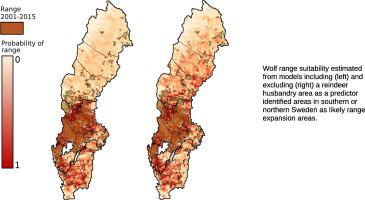当前位置:
X-MOL 学术
›
Biol. Conserv.
›
论文详情
Our official English website, www.x-mol.net, welcomes your feedback! (Note: you will need to create a separate account there.)
Identifying potential areas for an expanding wolf population in Sweden
Biological Conservation ( IF 5.9 ) Pub Date : 2018-02-21 , DOI: 10.1016/j.biocon.2018.02.019 Therese Eriksson , Fredrik Dalerum
Biological Conservation ( IF 5.9 ) Pub Date : 2018-02-21 , DOI: 10.1016/j.biocon.2018.02.019 Therese Eriksson , Fredrik Dalerum

|
Large carnivores have historically been decreasing worldwide, often as a result of human-carnivore conflicts. However, large carnivores are recovering throughout Europe, and European management scenarios can provide important insights into broad issues related to human-large carnivore existence. After becoming almost extinct in Sweden during the mid-19th century the Swedish grey wolf () population has now recovered. Current national wolf management aims to promote distribution shifts from the current areas in central Sweden, potentially also into a previously exempt reindeer husbandry area. Prior wolf re-introductions have highlighted the necessity of pro-active management for colonization success. Identification of likely range expansion areas could therefore be paramount for a successful Swedish wolf management. We characterized the demographic and spatial progression of Swedish wolves during 2001–2015 and used a MaxEnt approach to species distribution models to identify potential range expansion areas. The Swedish wolf population had expanded from 10 to almost 60 reproductions or territorial pairs, and increased in both range size and density. Our distribution models suggested that Swedish wolf management may face trade-offs between costs of hosting wolves in densely populated areas in southern Sweden with cattle and sheep and the costs of allowing wolves to expand into reindeer husbandry areas with associated cultural and economic consequences. Spatially explicit data on the economic, social and cultural factors associated with wolf conflict and acceptance may be paramount for developing optimal management strategies in the face of such a trade-off.
中文翻译:

确定瑞典狼群数量不断增加的潜在区域
从历史上看,大型食肉动物在世界范围内一直在减少,这通常是由于人类与食肉动物的冲突造成的。然而,整个欧洲的大型食肉动物正在复苏,欧洲的管理方案可以为与人类大型食肉动物存在相关的广泛问题提供重要的见解。瑞典灰狼 () 的数量在 19 世纪中叶几乎灭绝后现已恢复。当前的国家狼管理旨在促进瑞典中部现有地区的分配转移,也可能转移到以前豁免的驯鹿饲养区。之前的狼放归强调了积极主动的管理对于成功殖民的必要性。因此,确定可能的活动范围扩展区域对于瑞典狼的成功管理至关重要。我们描述了 2001 年至 2015 年瑞典狼的人口和空间进展特征,并使用 MaxEnt 方法建立物种分布模型来识别潜在的范围扩张区域。瑞典狼的种群数量从 10 只增加到近 60 只繁殖体或领地对,并且分布范围和密度均有所增加。我们的分布模型表明,瑞典狼管理可能面临在瑞典南部人口稠密地区饲养牛羊的成本与允许狼扩展到驯鹿饲养区的成本之间的权衡,并产生相关的文化和经济后果。与狼冲突和接受相关的经济、社会和文化因素的空间明确数据对于在面临这种权衡时制定最佳管理策略可能至关重要。
更新日期:2018-02-21
中文翻译:

确定瑞典狼群数量不断增加的潜在区域
从历史上看,大型食肉动物在世界范围内一直在减少,这通常是由于人类与食肉动物的冲突造成的。然而,整个欧洲的大型食肉动物正在复苏,欧洲的管理方案可以为与人类大型食肉动物存在相关的广泛问题提供重要的见解。瑞典灰狼 () 的数量在 19 世纪中叶几乎灭绝后现已恢复。当前的国家狼管理旨在促进瑞典中部现有地区的分配转移,也可能转移到以前豁免的驯鹿饲养区。之前的狼放归强调了积极主动的管理对于成功殖民的必要性。因此,确定可能的活动范围扩展区域对于瑞典狼的成功管理至关重要。我们描述了 2001 年至 2015 年瑞典狼的人口和空间进展特征,并使用 MaxEnt 方法建立物种分布模型来识别潜在的范围扩张区域。瑞典狼的种群数量从 10 只增加到近 60 只繁殖体或领地对,并且分布范围和密度均有所增加。我们的分布模型表明,瑞典狼管理可能面临在瑞典南部人口稠密地区饲养牛羊的成本与允许狼扩展到驯鹿饲养区的成本之间的权衡,并产生相关的文化和经济后果。与狼冲突和接受相关的经济、社会和文化因素的空间明确数据对于在面临这种权衡时制定最佳管理策略可能至关重要。


























 京公网安备 11010802027423号
京公网安备 11010802027423号